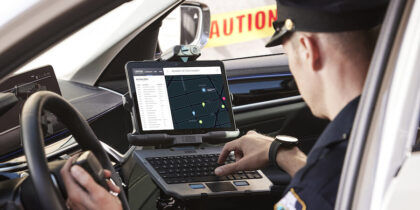Protecting our nation “from sea to shining sea” can’t be done from behind a desk alone. The more than 70,000 Department of the Interior (DOI) employees managing over 500 million acres of public lands must find effective ways to operate from some of the most remote areas of the United States. From national parks to tribal lands, protecting citizens, resources, waterways and animal species requires mobile tools that can keep pace with DOI’s on-the-go workforce.
Mobility can be transformative for agencies like DOI by bringing data to the fingertips of those who need it most, so they can do more on the move. In fact, a recent Frost & Sullivan survey of 500 managers and executives found that smartphones increased work productivity by an estimated 34 percent. Adopting a mobile-first strategy isn’t just good for productivity — it can also help DOI maximize IT budget resources by reducing the need to purchase and maintain a costly desktop/laptop fleet.
Digitize Your Government Agency
Get this guide to drive collaboration, boost productivity and ensure security in the public sector. Download Now
Here are three compelling examples that illustrate the power of mobility when it comes to supporting DOI’s mission priorities:
Improve Data Collection in Field
Field data is the lifeblood of DOI operations — whether it’s the National Park Service (NPS) managing efforts around natural resources conservation and protection or Bureau of Reclamation’s work to monitor the quality of our waterways. Samsung Galaxy tablets, like the rugged Tab Active2, incorporate GIS information to deliver personnel the ability to collect, access and manage data securely, even in tough, sometimes austere environments. Mobile access is particularly important for work done by departments such as the United States Geological Survey (USGS), which must maintain accurate maps for a range of civil engineering, hazard identification and environmental analyses purposes, and then feed that information to other agencies and the public.
Enhance Emergency Response Efforts
DOI’s Office of Emergency Management (OEM) often works together with the Federal Emergency Management Agency (FEMA) on disaster response. Mobile technologies can play a vital role in all stages of an emergency by ensuring the agency is prepared to respond to or continue operations in the face of imminent or catastrophic events. Smartphones can help with emergency coordination and collaboration, as well as improve situational awareness for on-the-ground responders. For hazardous environments, like a forest fire, wearables like the Samsung Gear S3 can help keep responders safe by monitoring health and performance.
Enforce the Law Across the Land
Although not known to all, DOI has the third largest federal law enforcement officer contingent in the Executive Branch, with 3,500-4,000 law enforcement officers and rangers monitoring for illegal activities, depending on the season. For example, DOI’s Opioid Reduction Task Force is working closely with the Drug Enforcement Administration (DEA) to address the epidemic and seize drugs across lands. Mobile productivity solutions like Samsung DeX — which connects the latest Galaxy smartphones to a monitor, keyboard and mouse for a desktop experience powered by the phone — can now be deployed in-vehicle, so officers can access information across environments, regardless of whether they’re processing paperwork in the office, driving to a call or patrolling on foot.
Enhancing productivity and saving costs alone are compelling reasons to invest in mobile solutions, but not enough by themselves — solutions must also be secure. Presidential Executive Order 13800 set the tone for agencies when it comes to implementing strategies for mitigating harmful cyber threats. DOI has taken this guidance seriously and is committed to protecting “… its critical information assets from cyber exploitation and attack to ensure that employees and the public can rely on the confidentiality, integrity, and availability of the DOI’s data and information systems.” That’s why it’s critical that all mobile solutions are protected down to the hardware level with seamless, defense-grade platforms such as Samsung Knox that still allow users high flexibility, without sacrificing security.
DOI’s increasingly mobile workforce requires streamlined devices to handle complex work wherever it happens, whether from an office to a city doorstep or forest land. If deployed correctly and securely, a mobile-first approach can drive significant cost savings and enhance mission readiness for DOI. Because not all missions happen in an office — for DOI, they are also carried out in the field.
Learn how Samsung’s government mobility solutions can help federal agencies meet mission objectives.








